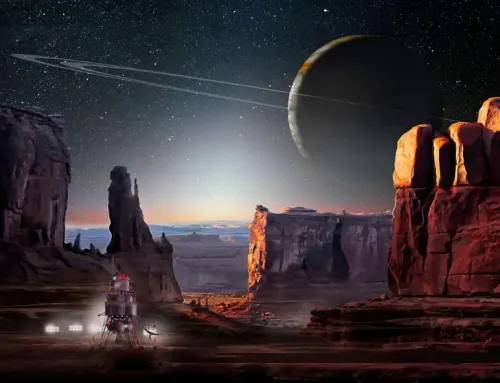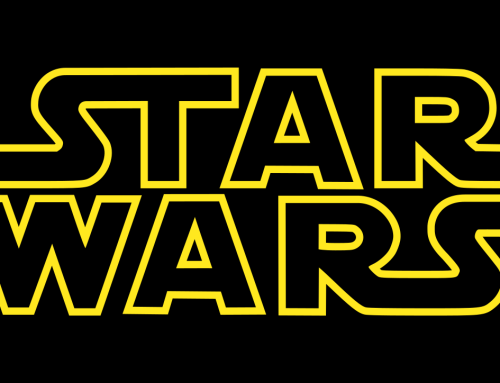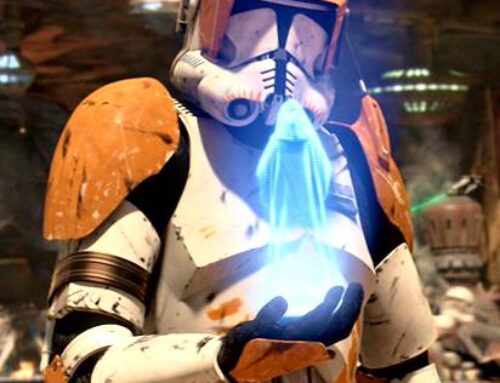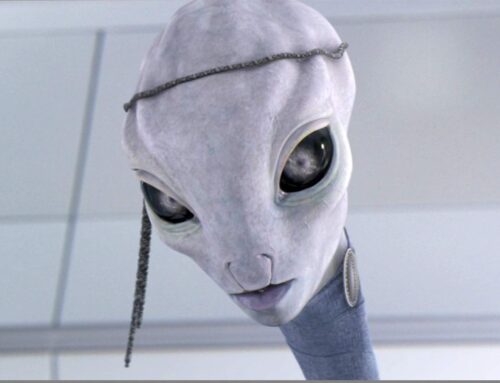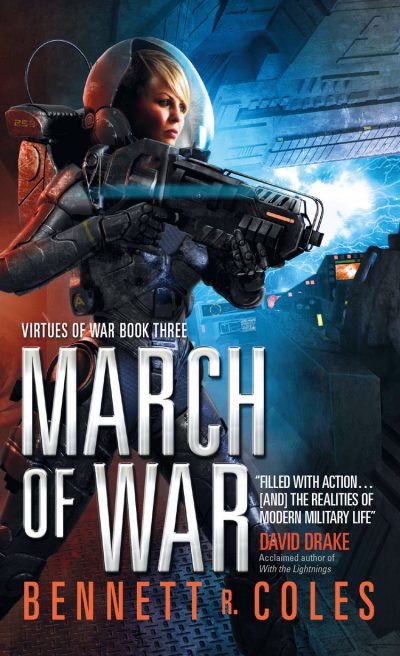Top 10 Best Star Wars Books (In This Author’s Opinion)
I love movies, especially Star Wars movies, for the sheer spectacle, but it’s in books that the Star Wars universe really comes to life. Authors can dive deep into characterization, or into themes the movies can’t properly unpack, or just head out into the galaxy and show us something new.
Star Wars Books in the Early Days
Today there are hundreds of Star Wars novels and comics spanning hundreds of years of Star Wars history. It would be impossible to review (or even read) them all – unless you were old enough to read when the original Star Wars movie came out. Back then, there were precisely two Star Wars books.
The first was the novelization of the movie called Star Wars: From the Adventures of Luke Skywalker. It was released in 1976 – six months before the movie! The second was Splinter of the Mind’s Eye by Alan Dean Foster, released in 1978, which was designed to be a follow-on to the movie (since nobody at that time expected a second movie would ever be made…)
I was five years old when my older brother got a copy of Splinter, and all I remember is that I was scared by the dark figure of Darth Vader on the cover. Needless to say, I never read it. Sorry, Alan…
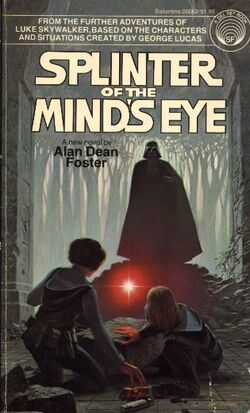
The (First) Thrawn Trilogy
But of course Star Wars didn’t end with a single movie and a pair of books, but went on to be the biggest sci fi phenomenon in the world (suck it, Trekkies). The Empire Strikes Back stunned audiences and Return of the Jedi gave us the triumphant ending we all wanted. You might think at this point that an endless stream of Star Wars books was inevitable.
But then a strange thing happened. The world moved on, and Star Wars drifted into the background. I remember as a high schooler in the late 80’s mentioning Star Wars to some younger kids, and they reacted with scorn.
“That’s old,” they scoffed.
By 1990, it seemed Star Wars might just disappear.
And I’m not the only one who thought this. I had the chance to meet Alan Dean Foster at WorldCon 2015 and he commented on how, when he first pitched the idea of writing Star Wars novels in the very late 80’s, he was met with confusion and perhaps a little pity. Star Wars, he was told by the industry, was a dead franchise. Nobody wanted to read books about it.
Oh, how wrong they were.
Grand Admiral Who?
The first Star Wars novel to roar back onto book shelves was Timothy Zahn’s Heir to the Empire, originally pitched as the official sequel to the Original Trilogy (or, the Star Wars Trilogy, as it was known then). Thousands of Star Wars fans put down their Nintendos and rushed out to buy it, eager to see what happened to their beloved heroes and to once again visit the Star Wars universe.
But it wasn’t the return of Luke Skywalker, Han Solo, Leia Organa et al that caused the most discussion. Zahn introduced a new antagonist, Grand Admiral Thrawn, who gathered the scattered but still potent Imperial Fleet. Such was his impact on fans that this trilogy of novels, originally billed as the successors of Star Wars, became known as the Thrawn Trilogy.

Enough Star Wars books to fill a space cruiser
And from there, the entire galaxy was once again open to story tellers. In what became known as the Expanded Universe, some of the best Star Wars books were written by up and coming authors who broke away from George Lucas’ original vision and built something much bigger. New characters like Mara Jade became fan favorites and adventures took place in the Old Republic, the New Republic, the Jedi Academy and elsewhere. There was political intrigue, awesome battles and romance (although usually written in a young adult writing style, just to stay loyal to the Star Wars film ratings). You were as likely to see a book centered on a Sith Lord as a Jedi Master, and some books dared to explore darker themes that the movies had never touched.
Even with the arrival of the Prequel Trilogy the Expanded Universe just kept on expanding, with little thought to what was considered Star Wars canon.
The Great Reboot
But then… A threat more ominous than the Death Star loomed into view: Disney. The Mouse House bought Lucasfilm and reviewed the entire Star Wars franchise, deciding to wipe the slate clean and declare a new canon. The six existing movies and Star Wars: The Clone Wars were spared, but every Star Wars book written before 2014 was declared no longer canon.
One of my friends apparently loved this fact, crowing on social media, “So long, Thrawn!”
But many fans held a different opinion and Disney recognized that to completely remove these non-canon books made no sense. Instead, the Expanded Universe was renamed Star Wars Legends and pushed out of the new “official” Star Wars story.
The best Star Wars books… Gone?
This was done primarily to make room for original Disney creations like Star Wars: Rebels, The Force Awakens, Rogue One, and all the other new movies and TV shows. It’s true that the Star Wars universe had grown somewhat scattered and messy, and Disney made what was perhaps a wise decision in stripping out all the extra stories and rebuilding from the core.
What once was lost…
As you can imagine, a lot was lost. Not only original characters like Thrawn, Mara Jade and Darth Bane, but many classic Star Wars characters were diminished as well – Obi Wan Kenobi is way more interesting in the Expanded Universe than he ever got to be in the movies.
The separation of the new canon and Legends can still rankle some fans so I’m not going to dwell on it, other than to say that the best Star Wars books reside on both sides of the “new canon debate” so I encourage any interested reader to ignore the Legends banner on the front cover and just pick up the book that most interests you.
…But now is found
And the good news is, Disney didn’t just chuck everything from the old Star Wars books in the dumpster, but instead used it as a source of inspiration for the new direction of the franchise. Characters, locations and concepts have worked their way into the new Star Wars canon through film, TV, video games… and novels. Part of the reboot was a renaissance of Star Wars books – mostly centered around the new canon but also stretching outward into a new… (I can’t say expanded) augmented universe.
My Top 10 Star Wars Books
I have no doubt that any voracious reader of Star Wars books will have different opinions from me about what the best Star Wars books are. That’s cool. I fully confess that my opinion may be skewed by the fact that I’m a military sci fi author and my interests naturally lean toward the military side of Star Wars. It’s why I know that Rogue One is the best Star Wars movie (yes it is – I will fight you) but when it comes to novels I respect that others have different opinions.
And despite my military leanings, my favorite books are driven by character, not action. This is an area where the movies always struggle to develop, simply due to time and the nature of the medium. Books are where characters can really come alive, where we can see depth and nuance that goes beyond just pop culture.
Not every book can make the list, of course, so I just want to take a moment and acknowledge these fine Star Wars authors: John Jackson Miller, James Luceno, Drew Karpyshyn and Delilah S. Dawson. You folks rock.
So here we go. If you’re just getting into Star Wars novels and are looking for some recommendations, here are my top 10 picks.
10) X-Wing: Rogue Squadron
Author: Michael A. Stackpole

Put “X-Wing” in the title and you know you have my attention. But this opening book of the X-Wing series is a great place to dive into the Expanded Universe. Centered around rebel hero Wedge Antilles shortly after Return of the Jedi, it follows the creation and development of of a new fighter squadron as the Rebellion struggles to transform itself into the New Republic. It has great battle scenes but it also has fascinating, lovable characters who breathe life into all those nameless Rebel pilots. If you ever wish you could have gotten to know Porkins, Biggs and the rest of Red Squadron from A New Hope, the characters in Rogue Squadron offer a worthy substitute.
9) Scoundrels
Author: Timothy Zahn

Quite a departure from typical Star Wars fare, Scoundrels can best be described as Ocean’s Eleven in that galaxy far, far away. Based shortly after A New Hope, a rudderless Han Solo finds himself tasked with gathering together a crew of questionables to undertake an impossible heist. But Imperial agents are sniffing around and Han’s target is a stronghold controlled by the sinister crime syndicate Black Sun. With the odds stacked against them, Han, Chewie, Lando and their misfit crew have to pull off the impossible and keep an eye out for danger, as much from within the group as without. With twist after twist, this is a fun book.
8) Lost Stars
Author: Claudia Gray

After Disney did the Great Reboot, they set out launching their new line of stories, and Lost Stars was one of the first. As a Star Wars book it already had a lot of pressure on it, but even more so because it served as a link between the much-loved Original Trilogy and the much-anticipated Sequel Trilogy. The fact that it was designed as a young adult novel only added to the pressure, as thousands of adult fans would no doubt scoop it up. Needless to say, Claudia Gray delivered a novel not only worthy of the Star Wars name, but something that went beyond the traditions of its predecessors. Lost Stars introduces two entirely new characters, whose lives intersect major events in the Star Wars universe but whose stories are unique. A story of lost love, mixed loyalties and grand adventure, this book set a new standard for what a Star Wars book can be.
7) Battlefront: Twilight Company
Author: Alexander Freed

I don’t normally put a lot of expectations on a book based on a video game, which is why I was very pleasantly surprised by Twilight Company. Centered around the Rebellion’s Sixty-First Mobile Infantry, it reads more like a World War II story than a space fantasy. Not since Clone Wars has this kind of close-unit, military drama taken center-stage and dragged us down into the intimacy of characters who fight together, who live and die together and who never, ever give up. This kind of story could easily have stayed small and local, but it certainly has its share of epic we all expect from Star Wars.
6) Battlefront II: Inferno Squad
Author: Christie Golden

Twilight Company warmed me up to the possibility of good Star Wars books coming out of video games, and Inferno Squad more than measured up. Based after the events of Rogue One / A New Hope, it follows the adventures of Iden Versio and her Inferno Squad, a small group of elite Imperial soldiers tasked to infiltrate the Partisans, the splinter Rebel group formerly led by Saw Gerrera. Unlike anything we see in the movies, Inferno Squad brings subtlety and depth to Imperial troopers – it shows that not all Imperials are cartoon villains who exist solely as cannon fodder for our wise-cracking, Rebel heroes. One thing I do credit Disney with is tackling the humanity hidden within the Empire, and the idea that not everything needs to be black and white.
5) The High Republic: Light of the Jedi
Author: Charles Soule
I was enchanted by this book, because it goes back in time to a period of galactic history before the corruption of the Dark Side threatened to ruin everything. Light of the Jedi shows us a Republic still on the rise, still optimistic, still bringing prosperity outward to the galaxy. The Jedi, likewise, are at their height and it’s refreshing to see Jedi characters who are genuinely at peace with their place in the universe. I’m not suggesting that this book is a love-in – there are some seriously bad villains and the opening section of the book is breathtaking in both its scope and high drama. I was also intrigued at the hints dropped about Jedi romances: perhaps future books in the High Republic will explore this idea, in a time before the rigid laws of the Jedi Order’s final days.
4) Star Wars: Thrawn
Author: Timothy Zahn

Having created one of the best-loved Star Wars characters of the page, and then seeing that character come alive as a major villain in Star Wars: Rebels, should we be surprised that Timothy Zahn was asked to rewrite the story of Grand Admiral Thrawn? This is the first book in a new Thrawn Trilogy, and it’s the best of the three, catching just the right balance of fanservice, tie-in to canon events and wonderful new material. It describes Thrawn’s arrival in the Empire and follows his rise from Academy cadet to Grand Admiral, introducing several likeable new characters and also bringing to life another villain from Rebels, Governor Ahrinda Pryce. If you’ve watched Rebels then you’ll understand what a masterstroke it was to make both Thrawn and Pryce into genuinely sympathetic characters, even as they both work to advance the Empire and their own ambitions.
As a side note, I met Timothy Zahn once, quite by accident. I was working for a small publishing house at a regional conference. Mr. Zahn was guest of honor and just happened to wander by my booth. Now remember, I’m an award-winning author myself, with ten years working in the industry at a publisher – I’ve met many big authors. But I guess I wasn’t expecting to meet anyone big that afternoon, and certainly not the creator of Thrawn. So what did I say?
“Are you the Timothy Zahn?”
Thankfully, Mr. Zahn was nothing but gracious. And my day was made.
3) Revenge of the Sith
Author: Matthew Stover

Writing the novelization of a blockbuster movie is no easy task. The author is inevitably working off an older version of the script (or even just a concept document) and the book itself is going to be judged by the success of the movie. Plus, not that many fans are going to read it, because they’ve already watched the movie. In general, I don’t expect a lot from novelizations.
(As an aside, I don’t envy Rae Carson, who did an admirable job at turning the pile of poodoo that was the film The Rise of Skywalker into a decent story – a Herculean task.)
Revenge of the Sith isn’t quite the worst Star Wars movie, but it’s pretty close. And this is frustrating because the bones of this story are just so awesome. All the elements were there, but for some reason the movie couldn’t pull it off. Thankfully, just last year I read an article on how the book version of Episode III accomplished what the film didn’t, and I gave it a shot.
Wow. Thank you, Matthew Stover, for re-imagining this story and giving us the fully realized and fully sympathetic tragedy that was the downfall of Anakin Skywalker. With a lyrical style and multiple points of view including Count Dooku and Mace Windu, the novel version of Revenge of the Sith turns Episode III into one of the best chapters of Star Wars.
2) Ahsoka
Author: E.K. Johnston

Sometimes I wish I was given the task of writing a novel centered around an established character with millions of fans. But then I realize what kind of pressure I’d be under and I reconsider. Ahsoka was one of the early “new canon” books and it picks up the story of our beloved togruta as she leaves the Jedi Order behind and tries to find her way in a galaxy falling under the shadow of the new Empire. On her own and trying to make a difference while hiding from Order 66, Ahsoka gets mixed up in a small farming community taken over for Imperial purposes.
The characterization of Ahsoka is consistent with what we saw in Clone Wars and Rebels, and this novel fills in some of the gaps in her story between the two TV series. She’s still a gearhead and she’s an incredible fighter when she needs to be, but we also see the awkwardness of Ahsoka as she navigates life beyond the Jedi. There’s an understated, cute moment when one of the main characters admits that she kind of likes Ahsoka (yes, in that way) and our former padawan really doesn’t know how to respond. For all the fan chatter of Ahsoka’s supposed romances with either Lux Bonteri or Barriss Offee, her character is usually presented on screen as asexual – perfectly reasonable for a person brought up their entire life to avoid making emotional attachments. Moments like this (and Ahsoka complaining to herself that her “head is still growing”) present a charming innocence grounded in the realities of regular life that’s loyal to the character we know.
E.K. Johnston is also the author of Queen’s Shadow, a novel about Padme Amidala. I haven’t read it so I can’t comment, but if Ms. Johnston brings the same subtle complexity to Padme as she does to Ahsoka, I’m sure it’s a winner, too.
1) Dark Disciple
Author: Christie Golden

How to pick the best Star Wars novel? For me, it’s not about the military action or the battles: it’s about character. And when I heard there was a novel centered around surfer-dude, bad-boy Jedi Quinlan Vos and the most exquisite villain in Clone Wars, Asajj Ventress, I knew I was there. Ventress was already a fascinating character from her five seasons on screen, and in this novel Vos seeks her out in order to learn more about the Dark Side so that he can assassinate Sith Lord Darth Tyrannus, otherwise known as Dooku. As a former Sith, Ventress knows her old master well, but the journey she and Vos take is dark. And it’s probably the most mature storyline Star Wars has ever told.
The Original Trilogy set the tone for Star Wars as kid-friendly – a heroic high adventure where the good Luke Skywalker, Princess Leia and friends would defeat the evil Darth Vader and minions. But The Empire Strikes Back introduced a maturity quite absent in A New Hope or Return of the Jedi, and decades later it’s widely considered the best film of the three. Dark Disciple is a return to this noir mood, with Vos and Ventress journeying deep into their own loves and fears. Dooku comes across as a genuinely threatening character, and his master, Darth Sidious, is always a shadow in the background. A strong story, a surprise ending and a look inside the soul of Asajj Ventress, my only regret is that this story will never be made into the film version it was originally conceived as. But maybe that’s for the best, because it probably wouldn’t have matched this triumph of a book.
Bennett R. Coles is an award-winning, best-selling author and ghostwriter of science fiction and space fantasy series. His newest novel, Light in the Abyss, is now available here.
![? ? [SPOILERS] [THR] "Star Wars: The High Republic – Light of the Jedi" official discussion. | Fandom](https://static.wikia.nocookie.net/a54a1279-2572-4003-9db2-29e1b1708d8e)
